(This written piece was originally published on my Patreon page on April 5, 2020. If you want more exclusive animator breakdown videos, look into the page directory, and consider subscribing.)
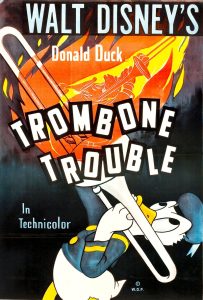 Here’s an animator breakdown I’ve wanted to present from the start: Trombone Trouble (1944) starring Donald Duck!
Here’s an animator breakdown I’ve wanted to present from the start: Trombone Trouble (1944) starring Donald Duck!
In today’s society, superhero characters and their role in the science-fiction genre have become an enormous and lucrative commodity in popular culture. When Jerry Siegel and Joe Shuster’s Superman first appeared in the summer of 1938 on the debut issue of Action Comics, other notable heroes proliferated in its wake shortly after, including Batman, Captain Marvel, The Flash, Captain America, Aquaman, and Wonder Woman.
In the early 1940s, Superman’s popularity warranted a series of animated cartoons produced by Max Fleischer, and later Famous Studios, for Paramount. At the same time, the Man of Steel’s influence and other subsequent superheroes lent themselves to story material suitable for parody, such as Chuck Jones’ Super-Rabbit (1943), which lampooned the Paramount cartoons. The most noteworthy animated takeoff was Super Mouse, later changed to Mighty Mouse, at Paul Terry’s studio, who became one of its most durable stars.
Initially titled Superduck and Superman Duck, Carl Barks was the principal story artist on this film, with Jack Hannah and Roy Williams contributing ideas. It is hard to determine when the film’s production started; an existing model sheet (with its approved title) dated August 1st, 1941, of Donald Duck and his noisy neighbor Pete indicates the film’s early stages. However, contemporaneous newspaper stories mentioning the film suggest that the Disney studio’s preoccupation with government-sanctioned propaganda films delayed its production at the height of World War II.
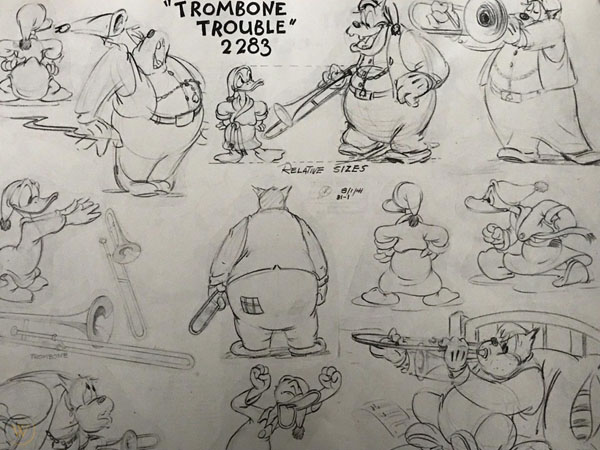
Barks left Disney on November 6th, 1942. The following day, Showmen’s Trade Review listed Trombone Trouble on the production schedule, with Motion Picture Herald reporting the film as a work-in-progress on its April 23rd, 1943 edition. Compared to surviving storyboards drawn by Barks, there is little deviation from the completed Trombone Trouble, retaining the concept of Donald receiving electrical powers from the gods above, who are just as aggravated with the nightly practices from Pete’s discordant trombone.
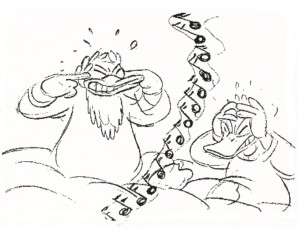 Under Donald’s principal director Jack King, six animators are credited in the production draft for Trombone Trouble, with much of the work dominated by Charles “Nick” Nichols and Wetzel “Judge” Whitaker. The other artists included are Paul Allen, Hal King, Marvin Woodward, and Les Clark. Clark is only credited for three small scenes in the film, presumably as a stopgap assignment since he usually animated on the studio’s feature-length films. Andy Engman and Jerry Hathcock are listed in the production papers for the special effects animation in the film. Bill Herwig is credited as the layout artist, while the probable background artist might have been Merle Cox, credited in subsequent Donald cartoons released in 1944.
Under Donald’s principal director Jack King, six animators are credited in the production draft for Trombone Trouble, with much of the work dominated by Charles “Nick” Nichols and Wetzel “Judge” Whitaker. The other artists included are Paul Allen, Hal King, Marvin Woodward, and Les Clark. Clark is only credited for three small scenes in the film, presumably as a stopgap assignment since he usually animated on the studio’s feature-length films. Andy Engman and Jerry Hathcock are listed in the production papers for the special effects animation in the film. Bill Herwig is credited as the layout artist, while the probable background artist might have been Merle Cox, credited in subsequent Donald cartoons released in 1944.
Judge Whittaker animates the opening scenes of Jupiter and Vulcan (voiced by John McLeish and animator Chester Cobb) high above the clouds, annoyed by the unpleasant notes from Pete’s trombone. They pull at their feathered heads in frustration, and sparks of lightning discharge from their hands, indicating their powerful capabilities. Donald tries to sleep through the noise back in the distant world until a warbling note causes a light bulb to fall on him. Paul Allen, one of the foremost Duck artists since the mid-1930s, is responsible for these scenes.
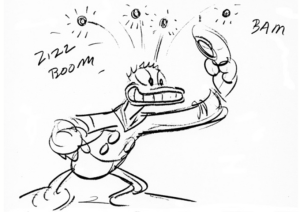 Whittaker handles the animation of Donald storming over to confront his neighbor, prefiguring the Duck’s backyard clashes with Neighbor Jones in Carl Barks’ comic book stories. After Donald demands a refrain from Pete’s trombone playing with his mocking of the instrument, Pete blasts a loud note, sending his neighbor back home, slamming him and a part of his bed frame into the plaster wall. To make matters worse, Donald receives another blaring note from Pete via telephone because the last note was in the wrong key!
Whittaker handles the animation of Donald storming over to confront his neighbor, prefiguring the Duck’s backyard clashes with Neighbor Jones in Carl Barks’ comic book stories. After Donald demands a refrain from Pete’s trombone playing with his mocking of the instrument, Pete blasts a loud note, sending his neighbor back home, slamming him and a part of his bed frame into the plaster wall. To make matters worse, Donald receives another blaring note from Pete via telephone because the last note was in the wrong key!
Whittaker animates more of Jupiter and Vulcan’s scenes, as they have witnessed Donald’s suffering and bestow some of their power to him through a lightning bolt. Hal King, an exceptional animator who usually gave the Duck a wide emotional range, handles the sequence of Donald testing his new powers. As electricity enters his body, Donald kicks a piano in a rage, and it flies across the room and crashes through a wall. (The production draft reveals a dual credit to Hal King and Charles Nichols for the shot of the damaged piano.) As animated by King, Donald’s realization of his newfound power is striking—drawn with concentric pupils and sharp fangs, he cackles with diabolical glee, enveloping much of the frame.
Charles Nichols’ animation takes over when Donald demonstrates superhuman strength, lifting the fence with one finger. The Duck rumbles and shakes Pete’s house, a disturbance Pete believes is an earthquake. When Donald reveals himself as the source, his face glows red, and two crackling bolts of lightning appear above his head, ready to unleash a more devilish approach to conquer his neighbor.
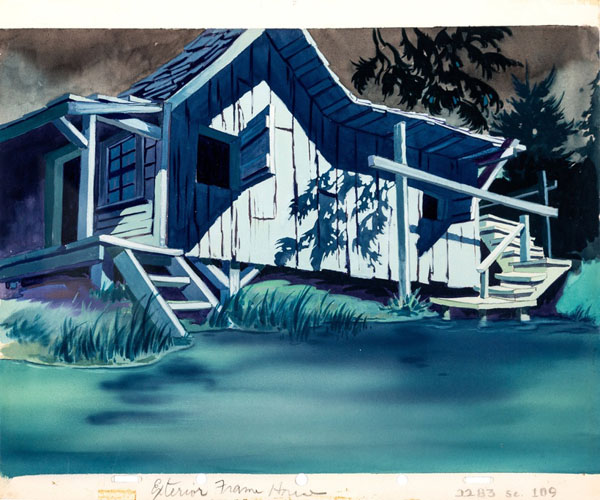
Original Background from “Trombone Trouble”
In the original storyboards for Trombone Trouble, Donald torments Pete by charging a train set and dropping it down Pete’s pants, and the toy travels up and down his clothes as he jumps around from its electrical jolts. In the finished film, Donald’s lightning powers send Pete out of his house, rolling near a cliff’s edge. The Duck turns his finger into a riveting machine and breaks off the edge of the precipice, and Pete lands near a large paddlewheel, which administers a spanking. Nichols animated the last few scenes of the two gods watching Donald with his new powers, then Marvin Woodward handles their final scenes as they lie down to sleep. Finally, Paul Allen animated the closing scenes of Donald finding Pete’s trombone and playing a “boogie-woogie” swing tune, much to Vulcan and Jupiter’s exasperation.
Before the release of Trombone Trouble, the May 1943 issue of Walt Disney’s Comics & Stories adapted the cartoon into a two-page text story. Only minor differences are present in the text story: for instance, the gods in the text feature are named Thor and Snor. The text slightly alters the ending when Donald picks up Pete’s trombone after his neighbor flees the house and leaves his instrument behind; the Duck plays a series of notes that are “twice as loud and twice as bad as Pete ever played.”

The final draft for Trombone Trouble is dated October 6th, 1943, two years after the early model sheet was approved. The film was released a few months later, on February 18th, 1944.
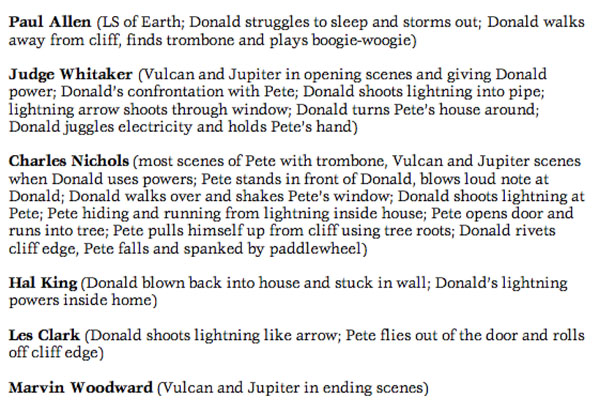
(Thanks to David Gerstein, JB Kaufman, Didier Ghez, Keith Scott, and Yowp for the information used in this post.)


 DEVON BAXTER is a film restoration artist, video editor, and animation researcher/writer currently residing in Pennsylvania. He also hosts a
DEVON BAXTER is a film restoration artist, video editor, and animation researcher/writer currently residing in Pennsylvania. He also hosts a 




















































































It’s too bad that Ward Kimball wasn’t assigned to animate “Trombone Trouble”. As a trombonist himself, he could have brought an interesting perspective to the cartoon; and as a train enthusiast, he would have enjoyed tackling the model train sequence from the storyboard that was omitted from the final film.
Trombonists hold their instrument rested on the left shoulder, with the slide held in the right hand. For this reason trombonists are almost always photographed in right profile, so the bell tube doesn’t cover their face. So it’s interesting that Pete is shown in left profile throughout both of his trombone-playing scenes. In fact, in the second one he plays the instrument in reverse, with the slide in his left hand! In a way, it complements the awkwardness and ineptitude of his playing.
The tune that Pete attempts to play is “Old Black Joe”. Even the “boogie-woogie” music that Donald plays at the end is just a jazzed-up version of it. Paul Allen’s animation in that scene is superb, and all too brief.
Pete is evidently a member of the Benevolent and Protective Order of Elks. The elk’s tooth watch fob he sports was a de rigueur accessory for lodge members at one time.
Demonic Donald rates right up there with the Coachman in Pinocchio (“They never come back…as BOYS!”) for freeze-frame nightmare fuel. Brrrr…
Interesting that this one is set in a none-too-prosperous neighborhood. By this time the Disney characters were usually placed in comfortable suburbs or idealized small towns, the depression-era shacks and farms largely forgotten except when plots required.
I noticed a bit of a continuity error.
When Donald goes to confront Pete, Donald is dressed in his night clothes. After Donald gets blasted back into his house, he lands in his bed and is slammed into the wall-and emerges from the wall wearing his usual sailor outfit!
This is Pete’s last appearance in theatrical shorts for eight years until Two-Gun Goofy in 1952. It seems the story people preferred to pair Donald with smaller opponents like Chip+Dale. He would battle Donald two more times in 1953.